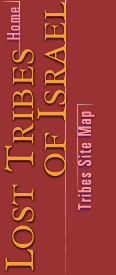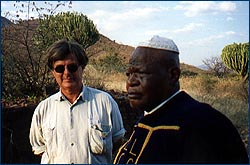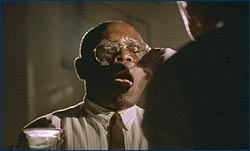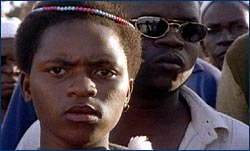 |

|
Tudor Parfitt's Remarkable Journey Part 2 | Back to Part 1 NOVA: How were you chosen to find Sena? Parfitt: I became very friendly with the spiritual head of the Lemba, Professor Mathiva, whom I met right at the beginning of my research. He specifically asked me on one occasion to go and find Sena. He could see that I was looking forward to a long journey and was excited by the prospect, and so it was a kind of commission. I was very pleased at the end of my journey to be able to offer at least a version of where they may have come from. I think it holds water. I think one can probably say that they do indeed come from the Sena which I located.
Parfitt: I was talking to an Imam in the holy town of Terim, and it was he who first spelled out the possibilities of this Sena, which I had never even heard of. I had been thinking that the Lemba's Sena might be Sanaa, the capital of Yemen, or some other place, possibly even Sayhut, which is one of the adjoining towns that sounds rather like Sena. He said, "Oh, no no, there's actually a place at the end of the Wadi Masilah that is called Sena to this day." NOVA: When you got to Sena, what about it made you feel that this was it, as opposed to Sanaa or somewhere else? Parfitt: Well, quite a number of things seem to pull together. The old tradition of the Lemba that they crossed Pusela seems very similar to the Masilah, which they would have to cross in order to get from Sena down to the sea. The camel trains went down the Masilah river valley to the port town of Sayhut. The fact that Sayhut on the southern coast of Arabia was a port par excellence for the Arab exploration of Africa. From there they could go to Mombasa or Zanzibar or down as far as Sofala in Mozambique in a matter of days. It wasn't a difficult journey because of the precise conjunction of tides and winds. They couldn't have done the same journey from, let's say, Aden, which is a bit farther west towards Africa. Then there's the fact that within the area of the eastern Hadramaut [a valley in southern Yemen where Sena is located], so many of the tribes had precisely the same tribal names as did the Lemba—the Sadiki, the Hamisi, and so on. And then there's the story of the dam. At one point in the past Sena was a considerable town, which was supported by a mighty, stone-built dam that permitted intensive irrigation. We know that at a certain point in history, perhaps around about the tenth or eleventh century, this dam cracked and thereafter the area wasn't able to sustain a large population and people left, as the legends there have it.
Parfitt: Yes, Neil Bradman and I went to the Hadramaut and collected DNA samples over a number of days. I'd already collected large DNA samples of Lemba, and these went back to the lab in London. Once the analysis had been done, it seemed to show that there was something of an overlap, not specifically with Sena but with the general area of the Hadramaut. It looked entirely plausible that the Lemba Y chromosome and the Y chromosome that we collected in the Hadramaut area had similar features. In addition to that, there was the extraordinary finding of the Cohen modal haplotype. This is the element in the Y chromosome that appears to be a signature element, if you like, for the Cohanim or Jewish priesthood. The fact that we found this marker in such high concentrations in one of the Lemba subclans, the Buba—much higher, incidentally, than the general Jewish population—seemed finally to provide a real, useable link between the Lemba and Jews. NOVA: What are the implications, and questions, raised by this finding? Parfitt: Well, it was very exciting that the Cohen modal haplotype was there in such high quantities in the Buba subclan. I wasn't quite clear what it meant, and common prudence dictated that we deal very carefully with the material. But it did seem on balance that, even though it was impossible to say when this element got into the Lemba genetic stream, it was more probable that it had come from south Arabia simply on historical grounds.
NOVA: What was the most amazing thing to you about all this? Parfitt: Well, in a way I suppose it's the old adage that the observed interacts with the observer, so the Lemba today are completely different from the Lemba that I first met when I started on my journey several years ago. And as we speak, some North American Jews are arriving among the Lemba of South Africa on a two-year mission to bring them mainstream Judaism, complete with a library and with Torah scrolls and everything else. So as a result of my work, though it was in no sense intended, they have become, if you like, properly Jewish and recognized as such by quite a number of people, particularly in America. Photos: (1,3-7) Cicada Films. Where are the Ten Lost Tribes? | Tudor Parfitt's Remarkable Journey Mystery of Great Zimbabwe | Build a Family Tree | Resources Teacher's Guide | Transcript | Site Map | Lost Tribes of Israel Home Editor's Picks | Previous Sites | Join Us/E-mail | TV/Web Schedule About NOVA | Teachers | Site Map | Shop | Jobs | Search | To print PBS Online | NOVA Online | WGBH © | Updated November 2000 |
 Professor Mathiva, the Lemba's spiritual leader, convinced Parfitt to search for the lost city of Sena.
Professor Mathiva, the Lemba's spiritual leader, convinced Parfitt to search for the lost city of Sena.
 Genetic studies done on saliva samples taken from the Lemba reveal a possible link with peoples living in southern Arabia, where Sena is located.
Genetic studies done on saliva samples taken from the Lemba reveal a possible link with peoples living in southern Arabia, where Sena is located.
 Do the Lemba have a Jewish ancestry, as they claim? The evidence is mounting in their favor.
Do the Lemba have a Jewish ancestry, as they claim? The evidence is mounting in their favor.